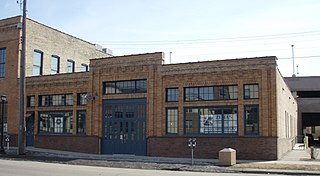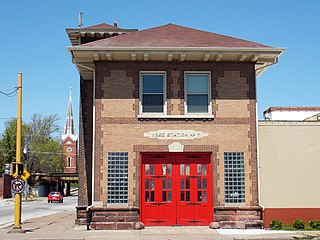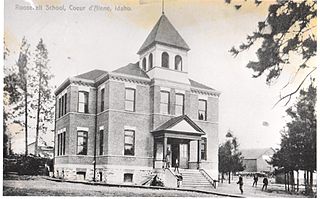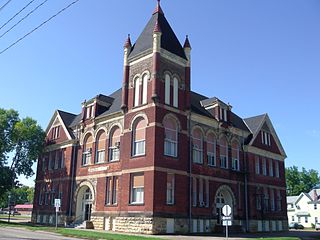
Sagamore Hill was the home of the 26th President of the United States, Theodore Roosevelt, from 1885 until his death in 1919. It is located in the Incorporated Village of Cove Neck, New York, near Oyster Bay in Nassau County on the North Shore of Long Island, 25 miles (40 km) east of Manhattan. It is now the Sagamore Hill National Historic Site, which includes the Theodore Roosevelt Museum in a later building on the grounds.

Thackeray Hall is an academic building of the University of Pittsburgh and a contributing property to the Schenley Farms National Historic District at 139 University Place on the campus of the University of Pittsburgh in Pittsburgh, Pennsylvania, United States.

Roosevelt Library is one of 41 community libraries in the Hennepin County Library System, originally part of the Minneapolis Public Library System as it is located in Minneapolis, Minnesota, United States.

This list is of the properties and historic districts that are designated on the National Register of Historic Places or that were formerly so designated, in Hennepin County, Minnesota; there are 171 entries as of July 2019. A significant number of these properties are a result of the establishment of Fort Snelling, the development of water power at Saint Anthony Falls, and the thriving city of Minneapolis that developed around the falls. Many historic sites outside the Minneapolis city limits are associated with pioneers who established missions, farms, and schools in areas that are now suburbs in that metropolitan area.

Comfort Station No. 72 is a historic visitor services building in Crater Lake National Park in southern Oregon, United States. It was built in 1930 to provide a public toilet and shower facilities for park visitors. It was constructed in the National Park Service Rustic style of architecture, and was listed on the National Register of Historic Places in 1988.

Fire Station No. 19, now the site of a Buffalo Wild Wings, and the architectural firm Station 19 Architects in Minneapolis, Minnesota, United States is centered in the University of Minnesota, Minneapolis campus. The former Fire Station is listed on the National Register of Historic Places. It was built in 1893 in an era when Minneapolis was growing rapidly. Rapid development was bringing prosperity to Minneapolis, but it was also starting to tax the city's infrastructure. Residents and businesses on the east bank of the Mississippi River were demanding better fire protection, especially after the fire that consumed the University of Minnesota Old Main building in 1892 along with some grain elevators nearby. Fire Station No. 19 was built in a simple utilitarian style, yet it contained some touches of ornamentation. It was built with a bell tower that was later removed. The fire station was one of the last to house horse-drawn equipment, as late as 1922. A newer Fire Station 19 was occupied in 1976 one block to the south.

The New Amsterdam Historic District is a historic district located in Detroit, Michigan. Buildings in this district are on or near three sequential east-west streets on the two blocks between Woodward Avenue and Second Avenue. It was listed on the National Register of Historic Places in 2001.

Station 28 of the Minneapolis Fire Department is a former fire station in the Linden Hills neighborhood of Minneapolis, Minnesota, United States. The station was built in 1914, during a time when the population of Minneapolis was growing rapidly. The Linden Hills neighborhood was evolving from a remote lakeside community to a neighborhood fully integrated into the city. This period of expansion also saw the construction of Lake Harriet Public School in 1898, city sewers in 1905, and Linden Hills Community Library in 1911.

The Minneapolis Fire Department Repair Shop is a building in Minneapolis, Minnesota listed on the National Register of Historic Places in 2005. The repair shop was established by the city of Minneapolis to reorganize and consolidate the services of the fire department. The shop was also used to convert horse-drawn fire equipment to motorized vehicles.

There are 65 properties listed on the National Register of Historic Places in Albany, New York, United States. Six are additionally designated as National Historic Landmarks (NHLs), the most of any city in the state after New York City. Another 14 are historic districts, for which 20 of the listings are also contributing properties. Two properties, both buildings, that had been listed in the past but have since been demolished have been delisted; one building that is also no longer extant remains listed.

The Hose Station No. 7 is located along a busy thoroughfare in a light industrial area of the west end of Davenport, Iowa, United States. It was listed on the National Register of Historic Places in 1983.

Davenport Hose Station No. 3 is located in a commercial area on the east side of Davenport, Iowa, United States. It has been listed on the National Register of Historic Places since 1984. The building is one of two historic former fire stations on the east side that are still in existence. The other one is Hose Station No. 4 in the Village of East Davenport.

The Roosevelt Inn is located near downtown Coeur d'Alene in North Idaho. Originally built in 1905 as the Roosevelt School, it is recognized as a historic building listed on the National Register of Historic Places. It was converted into an inn in 1994.

Fire Station No. 30, Engine Company No. 30 is a historic fire station and engine company in the South Los Angeles area of Los Angeles, California.

Clinton High School and Public Library, also known as Roosevelt School, is an historic structure located in Clinton, Iowa, United States. It was listed on the National Register of Historic Places in 2012.

The LaPorte City Town Hall and Fire Station is a historic building located in La Porte City, Iowa, United States. The town hall/fire station portion of the buildings was completed in 1876, five years after the town was organized. The two-story, brick structure has a gable roof hidden behind a metal false front. A two-story brick addition was built onto the north side of the building in 1911 for a town jail. The fire station was housed on the main floor of the original building where the two round-arch doorways are located. The doorways were altered in 1950 to accommodate larger fire vehicles. A single story concrete block addition was built at the same time. The fire department operated from here until 1968, and the large doorways were restored to their original arched form in the 1970s. The second floor of the original building was utilized as the town hall until the 1930s when it moved to the former La Porte City Station. The space was rented to the local high school for classrooms until 1974. After the fire department moved out the building the FFA Agricultural Museum began to occupy part of the building, until it eventually occupied the whole facility. The building was listed on the National Register of Historic Places in 1977. The museum moved to another building on Main Street in 2001.

Fire Station No. 2, also known as El Mecca Shrine Club, is a historic building located in Waterloo, Iowa, United States. The city's paid fire department dates from 1904. Prior to that Waterloo was served by private fire companies. Built in 1907, this is the only early fire station left in the city. This building is an eclectic combination of the Renaissance Revival and the Romanesque Revival styles. It was designed by the prominent Waterloo architect John G. Ralston. The decorative elements on the main floor are found in the columns with foliated capitals that support a broad entablature. The second story is primarily brick with lighter stone accents for a polychromatic effect. The building was used as a fire station until 1969 when the city built five new stations. Black Hawk County used the building as an office to issue food stamps. El Mecca Shrine acquired the building in 1976 and converted it into a restaurant and club. It was listed on the National Register of Historic Places in 1988.

The Sioux City Fire Station Number 3, also known as the Firehouse Bar, is a historic building located in Sioux City, Iowa, United States. The city's fire department began when a group of volunteers formed the Fire Protection Organization in 1869. It was formally organized in 1876. This building was completed in 1929, and replaced an older structure from around 1884. Station Number 3 served an area that mostly contained commercial buildings on the east side of downtown and a warehouse district along the Floyd River. It served as the fire department headquarters for a short time when Station Number 1 was abandoned. It long served as a training station, and a wooden training tower was located here from at least 1924 and into the 1960s.

Cedar Rapids Central Fire Station, also known as Cedar Rapids Hose Company No. 1 and the Cedar Rapids Science Station, is a historic building located in Cedar Rapids, Iowa, United States. It served as the city's fire department headquarters and downtown fire station from 1918 to 1985. It replaced a frame structure in the northeast quadrant, and was part of a larger program of building new facilities for the local fire department. The building program was a response to a series of disastrous fires, changing technology, and the city's growth. This fire station served from the era of horse-drawn pumper wagons to the modern era of fire engines, pumpers, and hook and ladder trucks. The two-story, brick Mission and Spanish Colonial Revival structure was designed by local architect Charles A. Dieman. In the mid-20th century a two-story kitchen addition was built onto the back of the building.

Perham Village Hall and Fire Station, also known as the Perham Area Chamber of Commerce, is a historic building located in Perham, Minnesota, United States. Completed in 1906, the two-story brick structure replaced the old village hall that was in need of repair. A bond issue was passed by voters to construct a new building designed by Minneapolis architect Fremont D. Orff. Local contactor Alex Nelson was responsible for construction on the site of the old hall. The building features a rectangular plan, hip roof, and a corner bay with an open tower that rises above the roofline. It was designed as a multi-purpose facility. Council chambers, the fire station and jail were housed on the main floor, and a large hall used for various community functions was located on the second floor. City offices were moved to a different building in 1962, and the fire department moved to their own facility in 1977. The city retained ownership of the building and it continues to serve other city departments. The building was listed on the National Register of Historic Places in 1986.





























